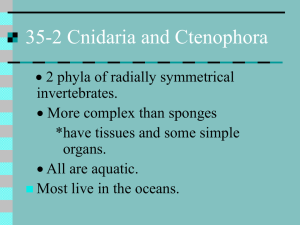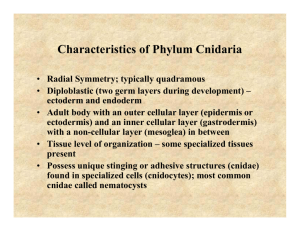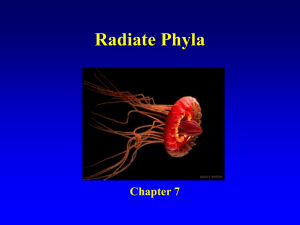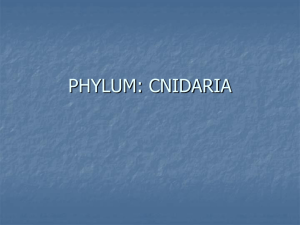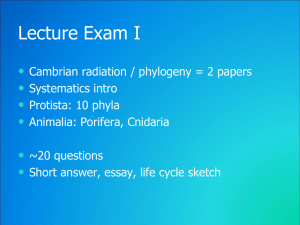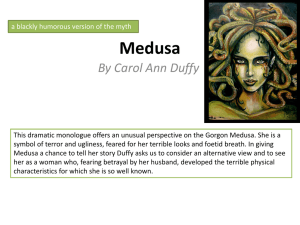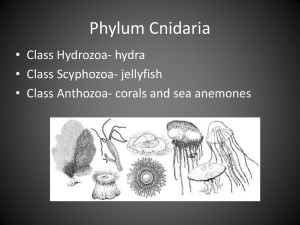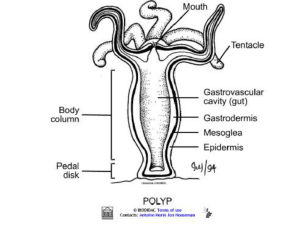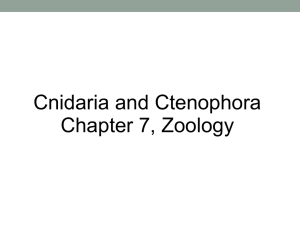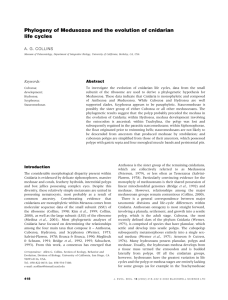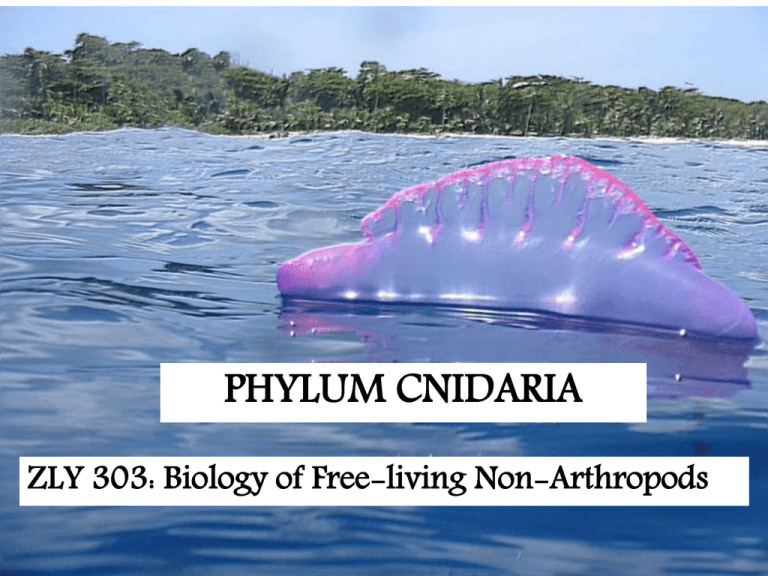
PHYLUM CNIDARIA
ZLY 303: Biology of Free-living Non-Arthropods
Classification
• Domain:
Eucaryota
• Kingdom:
Animalia
• Subkingdom: Eumetazoa
• Phylum:
Cnidaria
Cnidarians were classified into the following
Subphyla viz:
• Anthozoa (Sessile) e.g. Sea anemones,
Corals, Sea pens
– Ceriantharia (tube anemones),
– Hexacorallia,
– Octocorallia,
• Medusozoa
Classification
– Scyphozoa (Swimming) e.g. true jellyfish
– Cubozoa e.g. box jellyfish, Sea wasps
– Hydozoa (Sessile) e.g. Hydra and colonial swimmers
e.g. Portuguese Man o’ War (A diverse group that
include all freshwater cnidarians as well as many
marine forms).
Recently, the following group has been recognized as a class
rather than a sub-group of Scyphozoa; they include:
• Staurozoa (Stalked Jellies)
• Myxozoa (Parasites)
• Polypodiozoa (Parasites)
There is still debate whether they are
Cnidarians or Bilaterians
Phylogeny of Cnidaria
Four main classes (even though • have radiated into
most sources consider 3) stem
many habitats – yet
group - possess basic structural
body plan has been
organization of other more
retained.
Classes
For study purpose, the following classes shall be
considered:• HYDROZOA e.g. Hydra, Obelia
• SCYPHOZOA e.g. Aurelia aurita (Jelly fish)
• CLASS ANTHOZOA e.g. Sea anemones, Corals
• CLASS CUBOZOA e.g. Tripedalia cystophora, Sea
wasp
General Characteristics
• Possess the simplest degree of structural and
functional organization
• Exclusively marine, few sp. in freshwater
• They are acoelomates (lack coelom)
• Radially symmetrical
• There is diversity of body types found among the
members of this phylum.
• Has 2 distinct layers i.e. Ectoderm and Endoderm
and a thin layer of non-living jelly-like mesoglea
General Characteristics
• Tentacles around the mouth
• Tissues level of organization
• No choanocytes (flagellated collar cells of the
sponges)
• Alternation of generation with 2 morphologically
distinct stages:
• Polyp (sessile, remain attached, asexually
reproducing form)
• Medusa(motile, sexually reproducing form)
General Characteristics
• No excretory or respiratory organs
• Nerve net with symmetrical & asymmetrical
synapses
• Gastrovascular cavity used for both digestion and
excretion.
• Mesoglea (jelly-like non-living substance
between the two tissue layers (epidermis &
gastrodermis) for support).
• Hydrostatic Skeleton - chitinous, calcerous, or
protein.
General Characteristics
• Radiata have only two embryonic tissue layers.
• Specifically, no mesoderm (the tissue that gives
rise to structures, including muscles, in
triploblastic organisms).
• Lack sophisticated movement seen in triploblastic
organisms.
• Mouth: both ingestion & egestion- no anus
• Asexual reproduction by budding in polyps
• Sexually by gametes in all medusa & some polyps
Body Cavity Diversity
Why Cnidarians are ACOELOMATES
Cnidarians do not possess the following features,
hence, they are Acoelomates:-
– Coelom (also called the body cavity)
cavity within the body of all animals higher than the
coelenterates and certain primitive worms.
– Formed by the splitting of the
embryonic mesoderm into two layers.
– In mammals it forms the peritoneal, pleural, and
pericardial cavities.
Dimorphism & Polymorphism in Cnidarians
• A striking & puzzling feature
• Dimorphism: existence in polyp & medusa
• Polymorphism: colonies of some species have
morphologically differing
individuals each
specialized for certain roles e.g. feeding,
reproduction & defense.
Task differences in Hydrozoa
In Hydrozoans, colonial individuals arising from
individual zooids will take on separate tasks. For
instance, in Obelia there are:
• Feeding individuals referred to as the Gastrozooids;
• Asexual reproduction individuals only, referred to
as Gonozooids;
• Sexually reproducing individuals (medusae) and
are free-living, referred to as the Blastostyles
• Defensive individuals referred to as Dactylozooids
Polymorphism in Cnidaria
Differences between Medusa & Polyp
Polyp
• Sedentary or sessile life
• Non free swimming
• Has tubular body
• Simple body structure
• Velum absent
• Mouth is circular
• Mesoglea poorly developed
Medusa
• Adapted for a floating life
• Free swimming
• Bell or umbrella-shaped
• Complex structure
• Velum present
• Mouth rectangular
• Mesoglea highly developed
Attack & Defence Feature
• Cnidarians also have cnidocytes (specialized cells
that function in defense & capture of prey)
• Cnidocytes contain organelles called cnida, which
are able to evert (extend or retract).
• Cnida that sting are called nematocysts.
• These nematocysts can immobilize fish for capture,
and they can also be used for defence.
Coiled & Uncoiled Nematocysts
Types of Cnidocytes
1. Nematocysts: They have barbs which are used to
inject venom into prey. This is common to
almost all Cnidarians.
2. Spirocysts: They entangle the prey and do not
penetrate and inject the prey with venom.
3. Ptychocysts: They have tiny threads used for
building protective tubes for the organism to
habitate; they are not used for prey capture, this
feature is common to tube anemones.
Features of a Cnidocyte
• Cilium: A fine hair which projects above the
surface and acts as a trigger. They are absent in
Spirocysts.
• Cnida: A tough capsule which houses the thread
(payload) and contains mixture of chemicals like
venom, adhesives etc.
• Finger-like-extensible tube: Found on the wall of
the cnida so that when a cnidocyte fires, the finger
pops out and a set of barbs anchor the prey to
release venom.
Features of a Cnidocyte
• The thread: An extension of the "finger" and coils
round the prey until the cnidocyte fires. (The
thread is usually hollow and delivers chemicals
from the cnida to the target).
• Operculum: A lid covering the end of the cnida.
(The lid may be a single hinged flap or three
flaps arranged like slices of pie).
• Cell body: Produces all the other parts.
Firing Mechanism of Cnidocytes
Four theories were postulated by Hinde (1998):
1. Rapid contraction of fibers round the cnida may
increase its internal pressure.
2. The thread may be like a coiled spring that
extends rapidly when released.
3. Chemical changes in the cnida's contents may
cause them to expand rapidly by polymerization
e.g. Chironex (the "sea wasp").
4. Chemical changes in liquid of the cnida increases
the concentration, so that osmotic pressure forces
water in very rapidly to dilute it e.g. Hydrozoa,
Figure Showing Firing Sequence
Stimulus Required to Avoid Wastage in Firing
Cnidocytes
1. Their cilia detect contact, and nearby sensory
cells "smell" chemicals in the water. This
combination prevents them from firing at distant
or non-living objects.
2. Groups of cnidocytes are usually connected by
nerves and, if one fires, the rest of the group
requires a weaker minimum stimulus than the
cells that fire first.
The Hydrozoa e.g. Hydra vulgaris
• Class Hydrozoa includes hydras and the infamous
Portuguese Man-of-War, an organism noted for
its potent sting, in the medusa form.
• Most Hydrozoans exist in the polyp and medusa
forms.
• For example, some hydrozoans e.g. Obelia exist as
an asexually reproducing polyp that alternates
with a sexually reproducing medusa form (see
next slide).
Body plan of Hydra
Body plan of Hydra
• Epidermis consist:
• Epitheliomuscular cells (can self-reproduce) for
covering & muscular contraction
• Interstitial cells: differentiate to form the cnidoblast,
sex cells, buds, nerve cells.
• Gland cells- located around the basal disc and mouth,
secrete adhesive substance for attachment
• Cnidocytes- contain nematocyst for catching prey
• Sensory cells found around the mouth for detection of
stiimuli
• Nerve cells- synapse with sensory cells & other nerve
cells
Body plan of Hydrozoa: Hydra
Transverse Section through body wall of Hydra
Body plan of Hydra
• Gastrodermis consist:
• Nutritive-muscular cells all tall, columnar, large and
vacuolated with flagella at one end & microvilli at the
other end
• Interstitial cells: can transform to form other kind of
cells when the need arises.
• Gland cells- surround the mouth to aid feeding &
digestion.
• Mesoglea lies btw the epidermis & dermis and act like
a type of elastic skeleton
Biology of Hydra: Hydrozoans
• May be solitary or colonial
• Found in freshwater
• Hydra, unlike other hydrozoa exist as solitary(no
medusa or colonial forms).
• Cylindrical body shape
• Body size depends on level of contraction and
extension.
•
•
•
•
•
•
•
Movement in Hydra
Somersaulting- Can be found hanging downward
Walking
Looping
Floating
Climbing
Gliding
Swimming
Feeding & Nutrition In Hydra
• Use Tentacles to capture & direct the food
• Exclusively carnivorous
feeds on Cyclops,
annelids, crustaceans, insect larvae.
• Digestion in enteron (gastrovascular cavity)& is
both
• Extracellularly- the prey is killed by the action of
digestive enzymes from gland cells of
gastrodermis
• Intracellular- occur in the gastrovascular cavity
Feeding & Nutrition In Hydra
• Tentacles have many cnidoblasts in them for
capturing prey
• Nematocysts: Immobilize & paralyze the prey
• Inside the gastrovascular cavity, gland cells
secrete enzyme to digest the food.
• Egestion via the mouth.
Feeding process in Hydra
Reproduction in Hydrozoa: Hydra
• Mostly dioecious(male & female parts separate
• Reproduce both sexually & asexually by budding
• Zygote undergo holoblastic(complete) cleavage to
form the blastula.
• Cleavage is indeterminate(regulative)
• Fertilization: Cyst formed around the embryo
which break loose from parent to form the young
hydra.
Reproduction in Hydrozoa: Hydra
Biology of Obelia
•
•
•
•
•
•
•
Unlike Hydra, has both colonial & medusa form
Sedentary
It’s a plant-like Hydrozoa
Whitish in colour under microscope
Largely carnivorous
Use tentacles to capture prey
Digestion both extra & intracellular
Biology of Obelia
•
•
•
•
•
Dioecious
Fertilization is external
Mouth open into manubrium
Zygote forms planular larva
Statocysts are gravity receptor for maintenance of
balance
Obelia life cycle
The life cycle of Obelia, (Hydrozoan)
Alternation of Generation in Hydromedusoid
forms
Cnidaria Larva Types
A. Planula of Renilla
sp.
B. Planula of
Anemone Lebruina
C. Brooded Planula of
Urticinia filina
(anemone)
D. Planula of
Zoanthidea
E. Planktotropic
planula M. senile
F. Early & Late
planula of stone
coral
G. Actinula larva
Ceriantheria
Body plan of Scyphozoa: Aurelia aurita
Life Cycle of Jelly fish
Class Scyphozoa e.g. Jellyfish
• Cup-animals with umbrella or bowl-shape
• May attain a bell diameter of more than 2m
• Most scyphozoans range from 2 to 40cm in
diameter
• May be colourless, orange or blue
• Jellyfish exists predominantly in the medusa
form
• Mesoglea unusually thick giving the bell a
fairly firmed consistency
•
•
•
•
Biology of Class Scyphozoa e.g. Jellyfish
Predominantly Medusa, polyp form occurs only
as small larva during life cycle stage.
Thaumatosyphus hexaradiatus are unusual
member because medusa are sessile, attached to
seaweed
Movement is by rhythmical pulsation of the
umbrella
Tentacles may be few or short as in Aurelia
aurita or long as in Cyanea
Biology of Class Scyphozoa e.g. Jellyfish
•
•
•
•
•
•
Aurelia aurita is a common member
No velum or nerve rings
Oral arms bears the nematocysts
Have sense organ called rhopalium
Nervous system is made of a nerve net with
subumbrella net that control bell pulsations
Biology of Class Scyphozoa e.g. Jellyfish
• Sexes separate
• Sperm carried by ciliary current into gastric pouch
of female
• Internal fertilization
• Reproduction: The medusa sperm + egg = Zygote
• Ciliated planular larva emerge (Scyphystoma)
(hydra-like form), strobila ephyra
Class: Anthozoa
Sea anemone
Class Anthozoa
• E.g. sea anemones, corals , and sea fans.
• Anthozoans are all polyps, no medusa i.e. Not
Dimophic
• Symbioses between reef-building corals and the
dinoflagellates.
• In these relationships, corals provide housing
and protection for the protists, and the
dinoflagellates provide food for the corals.
• Members of all of the Cnidaria classes can
respond to external stimuli and can use stinging
nematocysts for prey capture and defense.
Anthozoa characteristics
• Flower-shaped, with body far more complex
than Hydrozoans
• Exclusively polyploidy, no medusa
• The most advanced of all marine Cnidarian
• Mouth lead to pharynx
• Gastrovascular cavity subdivided by septa, or
mesenteries into chamber
• Mesoglea stout with cells and fibres
• Skeleton secreted in the form of coral
• Nematoblast found in the body layers
Class Anthozoa e.g. The Corals
Biology of Anthozoans
Feeding
• Similar to Hydra polyp
• Aided with tentacles, cnidoblast and nematocyst.
• Pharynx lined with lateral ciliated grooves
• Movement by rhythmic contraction of muscles,
mesoglea and water in gastric cavity
Biology of Anthozoans e.g. Sea anemones
• Move by gliding slowly along the substrate on
their pedal disc
• Are carnivorous
• Can expand & stretch their tentacles to catch
the prey
• Nematocysts immobilizes the prey
• Pharynx with ciliated grooves: siphonoglyps
• When disturbed, can contract & withdraw
their tentacles and oral discs.
Biology of Anthozoans e.g. Sea anemones
Sexual Reproduction
• Sexes are separate
• Gonads borne on the margin of septa/mesenteries
• Fertilization occurs in enteron or externally:
• Planular larva emerge
Asexual Reproduction
• Occur by pedal laceration or at times budding
Diversity in forms
HYDROZOA
1.Life history features
both Polyp and
Medusa stages
2. Mesoglea non
cellular
SCYPHOZOA
True Jellyfishes have
conspicuous
medusoid form,
Polyploid larva stage
2. Mesoglea
thickened with fibres
and cells
ANTHOZOA
Sea anemones, coral
are all polyps
2. Mesoglea stout
with fibres and cells
CUBOZOA
Medusa
predominant
Class Cubozoa
• Class Cubozoa are the box jellies, which have
a box-shaped medusa form.
• Some species in this group are among the
most venomous organisms in the world and
their stings can be fatal to humans
Class Cubozoa
Most recently classified
Exist as both Polyp & Medusa
Medusa is the predominant form of this class
Cubozoa medusa may be about 25cm tall
Medusa are strong swimmer and voracious
predators
• Base of each tentacle form pedalium
• Tentacle(s) present in each corner of umbrella
margin
•
•
•
•
•
Class Cubozoa
•
•
•
•
•
Medusa dominant
Polyp state develop directly to medusa
Bell margin with velarium
Tetramerous (four part radial symmetry)
Bell may be cube or square-shaped with tentacles
arising from each corner.
• Gonads are endodermal (found in the gatrodermis)
• Specialized sense organ called rhopalium
Class Cubozoa

